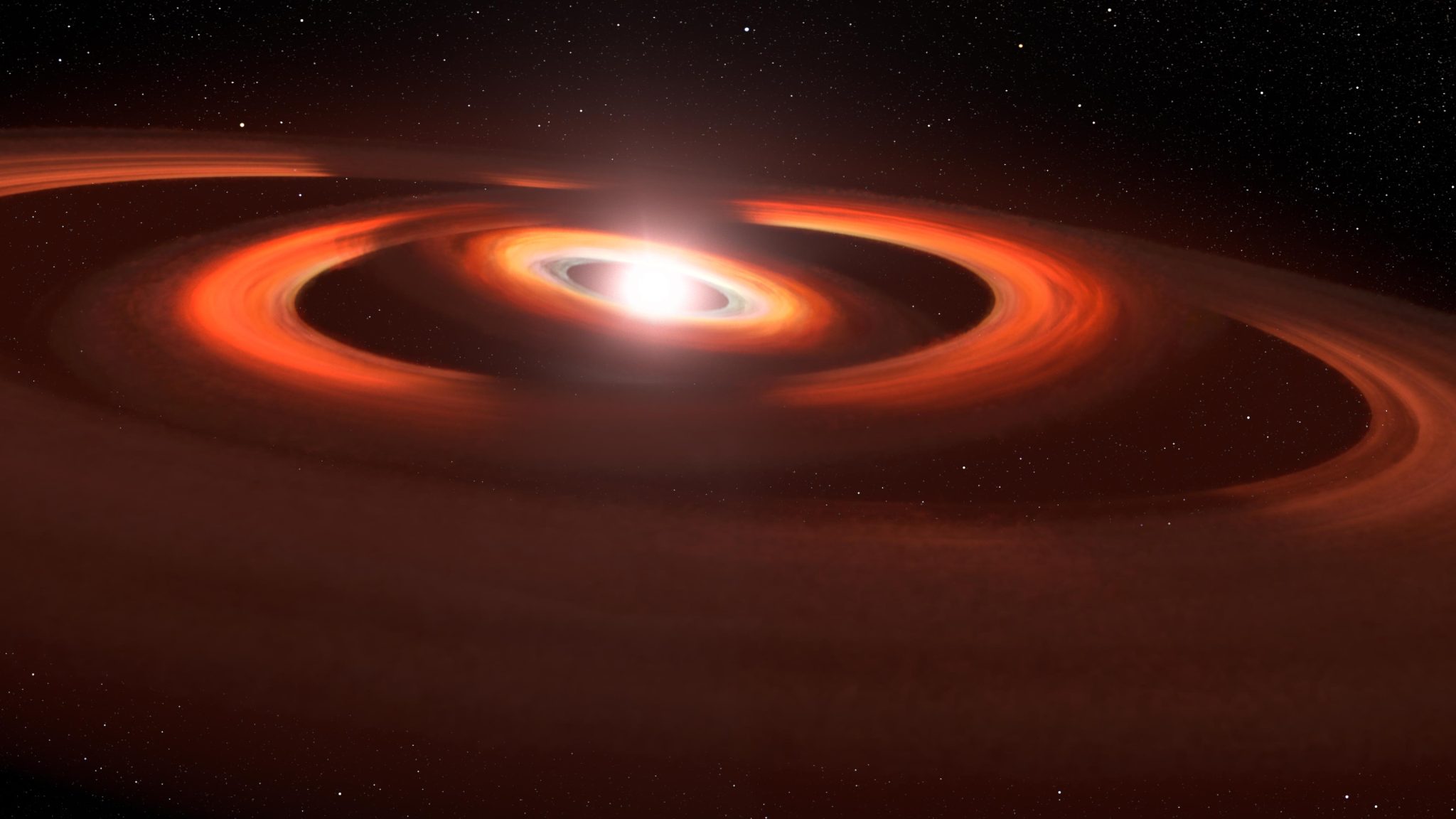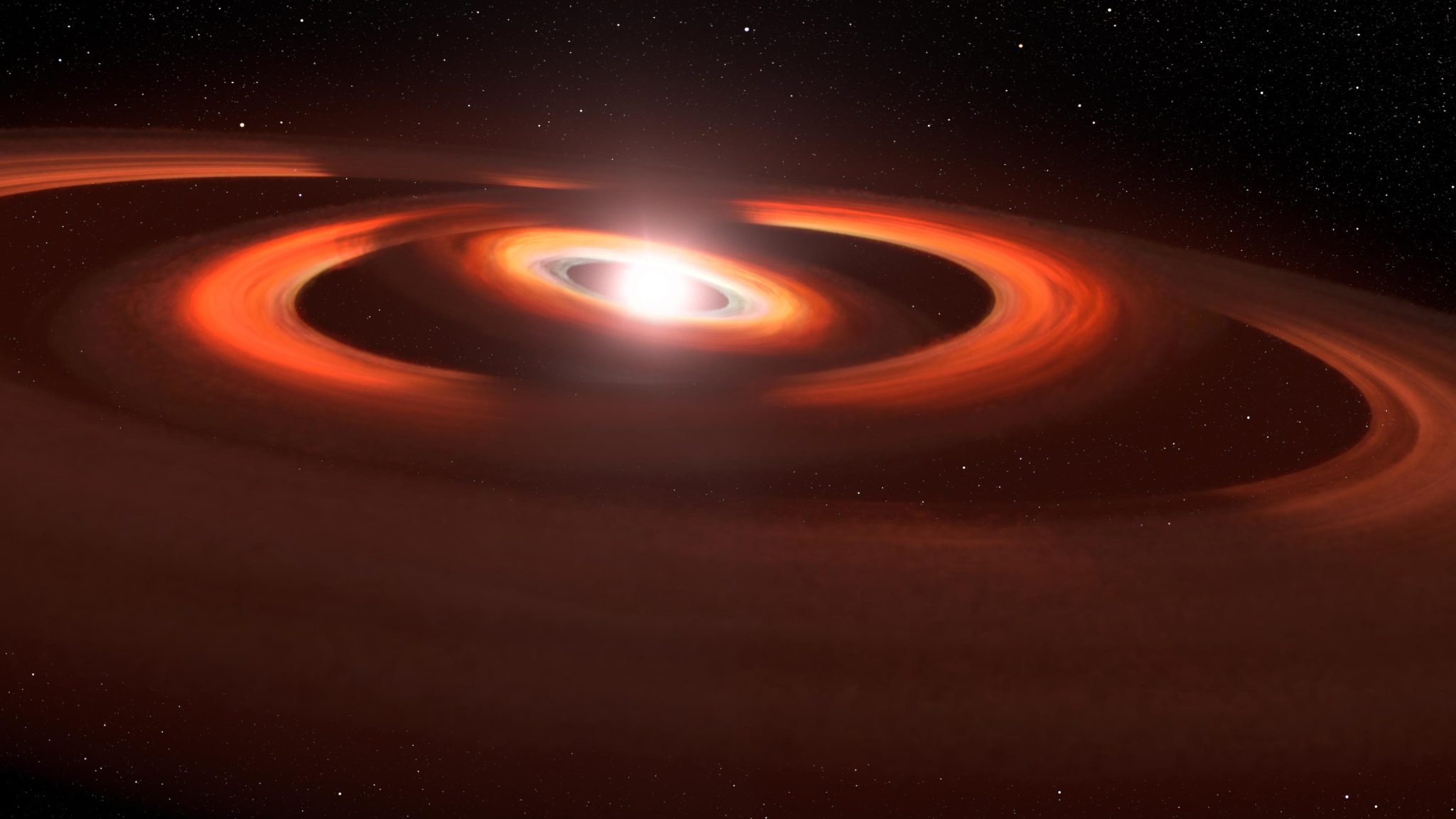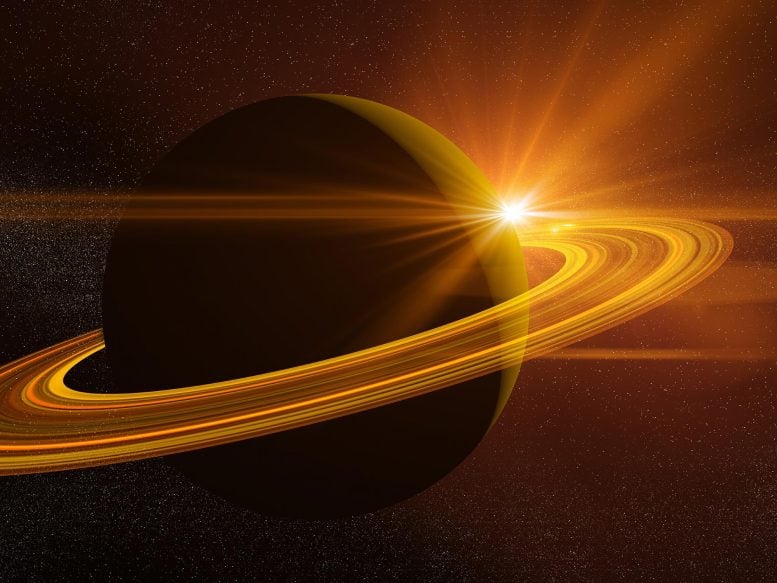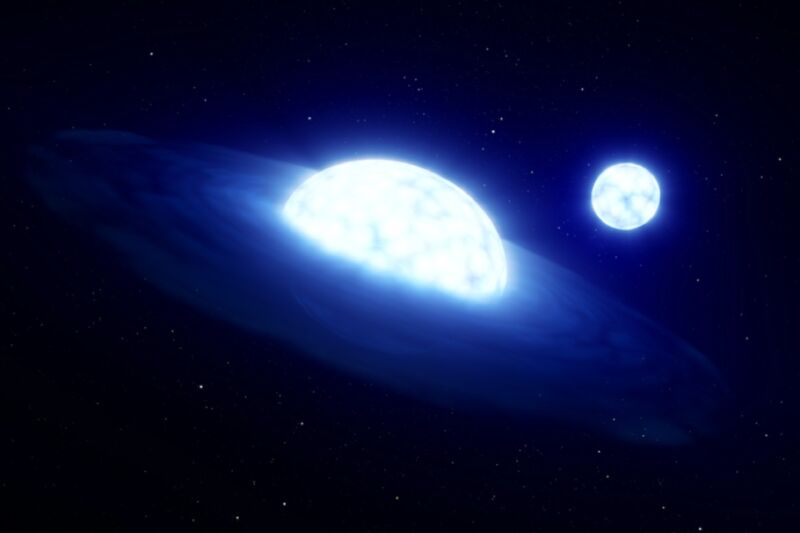
Η ιδέα αυτού του καλλιτέχνη βασίζεται σε εικόνες του διαστημικού τηλεσκοπίου Hubble από δίσκους με αέριο και σκόνη γύρω από το νεαρό αστέρι TW Hydrae. Οι εικόνες του διαστημικού τηλεσκοπίου Hubble δείχνουν σκιές που κατακλύζουν τους δίσκους που περιβάλλουν το σύστημα. Η εξήγηση είναι ότι αυτές οι σκιές προέρχονται από ελαφρώς κεκλιμένους εσωτερικούς δίσκους που εμποδίζουν το φως των αστεριών να φτάσει στον εξωτερικό δίσκο, ρίχνοντας έτσι μια σκιά. Οι δίσκοι γέρνουν ελαφρά ο ένας προς τον άλλον λόγω της βαρυτικής δύναμης των αόρατων πλανητών που παραμορφώνουν τη δομή του δίσκου. Πίστωση: NASA, Aura/STScI, European Space Agency, Leah Hostack (STScI)
Αφανείς νεογέννητοι πλανήτες ανασηκώνουν σκόνη γύρω από ένα νεαρό αστέρι
Ο κόσμος μας είναι τόσο άστατος που μερικές φορές του αρέσει να παίζει κρυφτό. Το 2017, οι αστρονόμοι έμειναν έκπληκτοι βλέποντας μια τεράστια σκιά να καταβροχθίζει έναν δίσκο σκόνης και αερίου που περιβάλλει το κοντινό νεαρό αστέρι TW Hydrae. Η σκιά δημιουργείται από έναν εσωτερικό δίσκο σκόνης και αερίου που είναι ελαφρώς κεκλιμένος προς το επίπεδο του εξωτερικού δίσκου. Η σκιά μπορεί να φανεί καθαρά μόνο επειδή το σύστημα γέρνει πρόσωπο με πρόσωπο στη Γη, δίνοντας στους αστρονόμους μια πανοραμική θέα του δίσκου καθώς η σκιά περιστρέφεται γύρω από το δίσκο σαν ένα χέρι που κινείται πάνω σε ένα ρολόι.
Αλλά το ρολόι έχει δύο δείκτες (για ώρες και λεπτά) που σαρώνουν με διαφορετικούς ρυθμούς. Και αποδεικνύεται ότι είναι και το TW Hydrae. Οι αστρονόμοι χρησιμοποίησαν το Hubble για να βρουν μια δεύτερη σκιά που αναδύεται από έναν άλλο εσωτερικό δίσκο, με κλίση προς τους δύο εξωτερικούς δίσκους. Ως εκ τούτου, το σύστημα εμφανίζεται όλο και πιο περίπλοκο με τουλάχιστον τρεις επικαλυπτόμενους δίσκους να έχουν ελαφρά κλίση μεταξύ τους. Οι δίσκοι είναι πληρεξούσιοι για αόρατους πλανήτες γύρω από το αστέρι. Κάθε πλανήτης τραβάει υλικό κοντά στο αστέρι με τη βαρυτική του δύναμη και παραμορφώνει αυτό που θα ήταν ένας απόλυτα επίπεδος δίσκος σε σχήμα τηγανίτας αν δεν υπήρχαν οι πλανήτες. Αυτό δεν προκαλεί έκπληξη γιατί οι πλανήτες στο ηλιακό μας σύστημα έχουν τροχιακά επίπεδα που διαφέρουν σε κλίση κατά μερικές μοίρες μεταξύ τους. Το TW Hydrae δίνει στους αστρονόμους ένα κάθισμα δίπλα στο δακτύλιο για να δουν πώς θα μπορούσε να ήταν το ηλιακό μας σύστημα κατά τη διάρκεια των χρόνων διαμόρφωσης του.

Οι συγκριτικές εικόνες από το διαστημικό τηλεσκόπιο Hubble, με διαφορά πολλών ετών, αποκάλυψαν δύο απόκοσμες σκιές που κινούνται αριστερόστροφα σε έναν δίσκο αερίου και σκόνης που περιβάλλει το νεαρό αστέρι TW Hydrae. Οι δίσκοι γέρνουν πρόσωπο με πρόσωπο στη Γη, δίνοντας έτσι στους αστρονόμους μια πανοραμική άποψη για το τι συμβαίνει γύρω από το αστέρι. Η αριστερή φωτογραφία, τραβηγμένη το 2016, δείχνει μόνο μία σκιά [A] Ώρα 11:00. Αυτή η σκιά ρίχνεται από έναν εσωτερικό δίσκο που είναι ελαφρώς κεκλιμένος προς τον εξωτερικό δίσκο και εμποδίζει το φως των αστεριών. Η εικόνα στα αριστερά δείχνει μια δεύτερη σκιά που έχει εμφανιστεί από έναν άλλο ενδιάμεσο δίσκο [C] Η ώρα είναι 7:00 όπως φωτογραφήθηκε το 2021. Το αρχικό εσωτερικό καντράν είναι σημειωμένο [B] σε αυτή την επόμενη παράσταση. Οι σκιές περιστρέφονται γύρω από το αστέρι με διαφορετικούς ρυθμούς όπως δεξιόστροφα. Είναι απόδειξη δύο αόρατων πλανητών που έχουν τραβήξει σκόνη στις τροχιές τους. Αυτό τα κάνει να γέρνουν ελαφρώς το ένα πάνω στο άλλο. Αυτή είναι μια εικόνα ορατού φωτός που λήφθηκε με το Φασματοραδιόμετρο Απεικόνισης του Διαστημικού Τηλεσκοπίου. Έχει προστεθεί συνθετικό χρώμα για να βελτιώσει τη λεπτομέρεια. Πιστώσεις: NASA, ESA, STScI, John Debes (AURA/STScI για ESA), Joseph DePasquale (STScI)
Το διαστημικό τηλεσκόπιο Hubble ακολουθεί ένα παιχνίδι σκιών γύρω από τον δίσκο που σχηματίζει τον πλανήτη
Ο νεαρός σταρ TW Hydrae παίζει «κούκλες σκιών» με τους επιστήμονες να τον παρακολουθούν[{” attribute=””>NASA’s Hubble Space Telescope.
In 2017, astronomers reported discovering a shadow sweeping across the face of a vast pancake-shaped gas-and-dust disk surrounding the red dwarf star. The shadow isn’t from a planet, but from an inner disk slightly inclined relative to the much larger outer disk – causing it to cast a shadow. One explanation is that an unseen planet’s gravity is pulling dust and gas into the planet’s inclined orbit.
Now, a second shadow – playing a game of peek-a-boo – has emerged in just a few years between observations stored in Hubble’s MAST archive. This could be from yet another disk nestled inside the system. The two disks are likely evidence of a pair of planets under construction.
TW Hydrae is less than 10 million years old and resides about 200 light-years away. In its infancy, our solar system may have resembled the TW Hydrae system, some 4.6 billion years ago. Because the TW Hydrae system is tilted nearly face-on to our view from Earth, it is an optimum target for getting a bull’s-eye-view of a planetary construction yard.
The second shadow was discovered in observations obtained on June 6, 2021, as part of a multi-year program designed to track the shadows in circumstellar disks. John Debes of AURA/STScI for the European Space Agency at the Space Telescope Science Institute in Baltimore, Maryland, compared the TW Hydrae disk to Hubble observations made several years ago.
“We found out that the shadow had done something completely different,” said Debes, who is principal investigator and lead author of the study published in The Astrophysical Journal. “When I first looked at the data, I thought something had gone wrong with the observation because it wasn’t what I was expecting. I was flummoxed at first, and all my collaborators were like: what is going on? We really had to scratch our heads and it took us a while to actually figure out an explanation.”
The best solution the team came up with is that there are two misaligned disks casting shadows. They were so close to each other in the earlier observation they were missed. Over time they’ve now separated and split into two shadows. “We’ve never really seen this before on a protoplanetary disk. It makes the system much more complex than we originally thought,” he said.
The simplest explanation is that the misaligned disks are likely caused by the gravitational pull of two planets in slightly different orbital planes. Hubble is piecing together a holistic view of the architecture of the system.
The disks may be proxies for planets that are lapping each other as they whirl around the star. It’s sort of like spinning two vinyl phonograph records at slightly different speeds. Sometimes labels will match up but then one gets ahead of the other.
“It does suggest that the two planets have to be fairly close to each other. If one was moving much faster than the other, this would have been noticed in earlier observations. It’s like two race cars that are close to each other, but one slowly overtakes and laps the other,” said Debes.
The suspected planets are located in a region roughly the distance of Jupiter from our Sun. And, the shadows complete one rotation around the star about every 15 years – the orbital period that would be expected at that distance from the star.
Also, these two inner disks are inclined about five to seven degrees relative to the plane of the outer disk. This is comparable to the range of orbital inclinations inside our solar system. “This is right in line with typical solar system style architecture,” said Debes.
The outer disk that the shadows are falling on may extend as far as several times the radius of our solar system’s Kuiper belt. This larger disk has a curious gap at twice Pluto’s average distance from the Sun. This might be evidence for a third planet in the system.
Any inner planets would be difficult to detect because their light would be lost in the glare of the star. Also, dust in the system would dim their reflected light. ESA’s Gaia space observatory may be able to measure a wobble in the star if Jupiter-mass planets are tugging on it, but this would take years given the long orbital periods.
The TW Hydrae data are from Hubble’s Space Telescope Imaging Spectrograph. The James Webb Space Telescope’s infrared vision may also be able to show the shadows in more detail.
Reference: “The Surprising Evolution of the Shadow on the TW Hya Disk” by John Debes, Rebecca Nealon, Richard Alexander, Alycia J. Weinberger, Schuyler Grace Wolff, Dean Hines, Joel Kastner, Hannah Jang-Condell, Christophe Pinte, Peter Plavchan and Laurent Pueyo, 4 May 2023, The Astrophysical Journal.
DOI: 10.3847/1538-4357/acbdf1
The Hubble Space Telescope is a project of international cooperation between NASA and ESA. NASA’s Goddard Space Flight Center in Greenbelt, Maryland, manages the telescope. The Space Telescope Science Institute (STScI) in Baltimore conducts Hubble science operations. STScI is operated for NASA by the Association of Universities for Research in Astronomy, in Washington, D.C.

“Ερασιτέχνης διοργανωτής. Εξαιρετικά ταπεινός web maven. Ειδικός κοινωνικών μέσων Wannabe. Δημιουργός. Thinker.”



